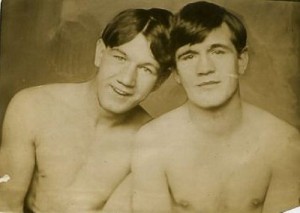Body Language
One of the ways we defend ourselves against hurt is by taking things we experience in the body and intellectualizing them, turning them into thinking, stories, or talking, so that we can get away from the discomfort of feeling them.
One of the techniques we use in Touch Practice is an intentional reversal of this process, something I call “mindful somatization” (if anyone has a better phrase, phone it in–that’s the best I can come up with at the moment, but it’s not exactly a catchy phrase, is it.) Let me give you some examples of how it works.
 If any of you have ever had some really, really bad news delivered–you get a phone call in the middle of the night that someone dear has died, or your boss calls you in to let you know that you’ve been fired, or there’s a knock on the door and someone hands you papers regarding a lawsuit or a divorce–you may recall that the very first thing that happens is a physical event, a pit-of-the-stomach, core-of-the-body event. People would describe it differently.
If any of you have ever had some really, really bad news delivered–you get a phone call in the middle of the night that someone dear has died, or your boss calls you in to let you know that you’ve been fired, or there’s a knock on the door and someone hands you papers regarding a lawsuit or a divorce–you may recall that the very first thing that happens is a physical event, a pit-of-the-stomach, core-of-the-body event. People would describe it differently.
It can feel like getting kicked in the stomach, or like someone is squeezing you and you can’t catch your breath. It feels like a physical blow, a strike, a hammer coming down on a piece of iron. It happens immediately, even before you have a moment to think about what has happened–literally, because it happens in a part of the brain other than the part that handles conscious thinking and reasoning. This pit-of-the-stomach event, called a fight-or-flight response, is triggered by a lower part of the brain, the hypothalamus, close to the stem, responsible for much of our autonomic survival. No thinking is required; that part of the brain doesn’t do thinking.
Most of us don’t stay with that body sensation very long and, in fact, it’s possible to go through an event like that without even noticing the physical sensation in the body. Most of us, pretty quickly, start to work on things in a different part of the brain, the cortex, higher up, by thinking, reasoning, writing stories, looking for meaning. That’s reasonable enough, and certainly helpful in certain ways. But it’s possible, indeed it’s likely, that at some point, we will get stuck there.
And if and when we get stuck, the event takes on a life of its own in our brain as we spin layer and layer of meaning and story onto what has happened. “You’re fired” becomes a story about how bad the boss was, years of being taken advantage of, should have left much sooner, unappreciated, mistreated (you know this story, right? We all have some little version, or big version, of this particular script, perhaps.)
And the story can go on for years, and take many variations and layers. We can work on the story by telling the story to others or having others help us think about the story, which sometimes helps us to metabolize and digest what has happened to us. And sometimes it doesn’t; sometimes it just provides a rich and sustainable source of employment for our psychotherapists while we keep running around the loop of our story like horses on a racetrack. (Talk-based psychotherapy can be really, really helpful; I believe in it. I also think that not every issue can be solved by talking about it.)
 Touch Practice sometimes involves creating an intentional reversal of that “out of the body, into the mind” process. We take what we’re feeling on an emotional level, thinking about, what life issues are weighing on us, whatever it is that we have assessed with our brains about our current condition, and we act that out in physical movement. You could call it dance if you want, although in most Touch Practice there’s very little movement, but sometimes, sure, it probably looks just like a slow motion dance, or a slow, graceful martial art. You could call it yogic in the sense that various postures tend to represent, symbolically, various inner states, just as Warrior or Mountain or Corpse poses in yoga tend to symbolize inner states, the posture of inner rest, for example.
Touch Practice sometimes involves creating an intentional reversal of that “out of the body, into the mind” process. We take what we’re feeling on an emotional level, thinking about, what life issues are weighing on us, whatever it is that we have assessed with our brains about our current condition, and we act that out in physical movement. You could call it dance if you want, although in most Touch Practice there’s very little movement, but sometimes, sure, it probably looks just like a slow motion dance, or a slow, graceful martial art. You could call it yogic in the sense that various postures tend to represent, symbolically, various inner states, just as Warrior or Mountain or Corpse poses in yoga tend to symbolize inner states, the posture of inner rest, for example.
Touch Practice is a way of bringing our stories to each other without using any words. Here’s an example of what a verbal version might look like, taken from an actual situation: “I’m a CEO of a international corporation, I probably work 50 hours a week, I’ve got a number of children ranging in age from 8 to 18, I’m responsible for everyone I know, my family, my employees, everyone, I try to get my work done, I try to get to the gym every two days and I try to spend time with my kids, but, good grief. I’m so tired of being the one responsible and in charge. I wish someone would just come along and take care of ME once in a while.” Takes a lot of words to describe that, and I’ve barely done it justice.
It’s possible to sit with that in Touch Practice without expressing a single word; we can rather easily find a number of postures that express “I want to be taken care of, I’d like someone else to keep me safe, instead of me being the guard dog all the time.” Paired up with a partner willing to act out the mirroring posture (“I’m willing to take care of you and keep you safe”) all of that gets done without having to tell a story, think too much, or express a single word.
 A further example, also from this particular story: falling asleep while being held, which happens often in Touch Practice, is one of the ways people express a number of complicated stories: a desire to give up being in control of everything; a desire to not have to work so hard, a need to rest, a desire to be taken care of, a desire to be vulnerable, and many stories that are too complicated to even attempt to put into words. It’s possible to put thinking and emotion back into the body just the way we put body events into thinking. It works both ways.
A further example, also from this particular story: falling asleep while being held, which happens often in Touch Practice, is one of the ways people express a number of complicated stories: a desire to give up being in control of everything; a desire to not have to work so hard, a need to rest, a desire to be taken care of, a desire to be vulnerable, and many stories that are too complicated to even attempt to put into words. It’s possible to put thinking and emotion back into the body just the way we put body events into thinking. It works both ways.
Outside of Touch Practice, mindful somatization has great individual applications. If you want to give this a try: the next time you feel irritated with your spouse or your kids or your boss or the neighbor, ask yourself, “ok, where is it in my body?” If you look, you will find that the manifestation of irritation happens SOMEWHERE in your body. Where is it? Are your shoulders a little higher and tighter than they need to be? Is there a knot somewhere in your stomach, or a “hitch” or “sharp edge” in your breathing somewhere? Find where the feeling is localized in the body and very gently direct your breath into that area.
The goal is not to fix or change anything. The goal is to bring mindful awareness to the language your body speaks, to bring breath (in-spir-ation–get it? inspiration just means “to breathe into!”) to those areas where we clench, where we struggle, where we hurt. The minute you can name it, look for it in the body, localize it, and get in-spired.
Have thoughts you’d like to share?
Touch Practice is a sacred practice for me, and part of that is keeping confidences sacred. While a name and e-mail address are required to post a comment, feel free to use just your first name, or a pseudonym if you wish. Your e-mail address will never be seen by or shared with anyone. It is used to prevent spam and inappropriate comments from appearing in the blog. I’d really like to hear from you!













